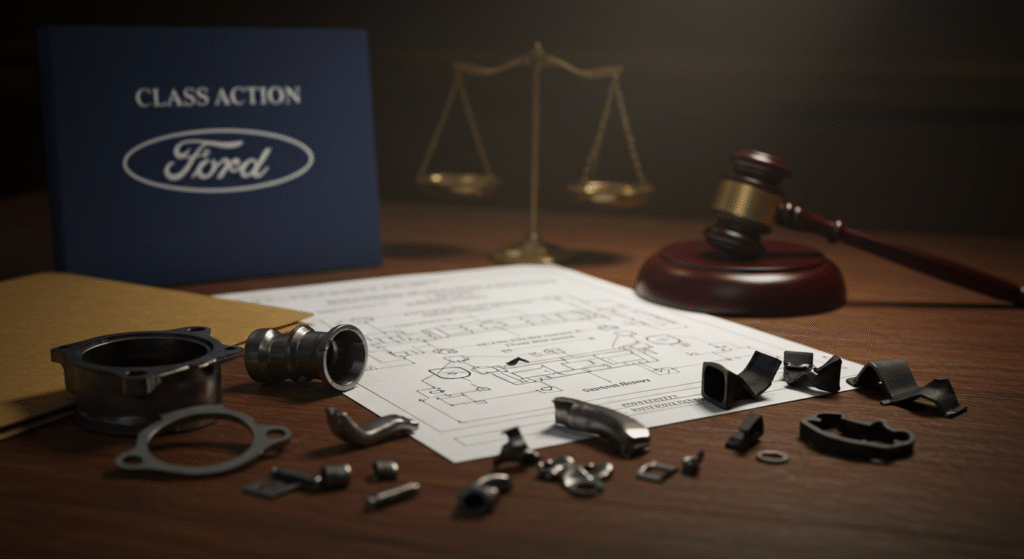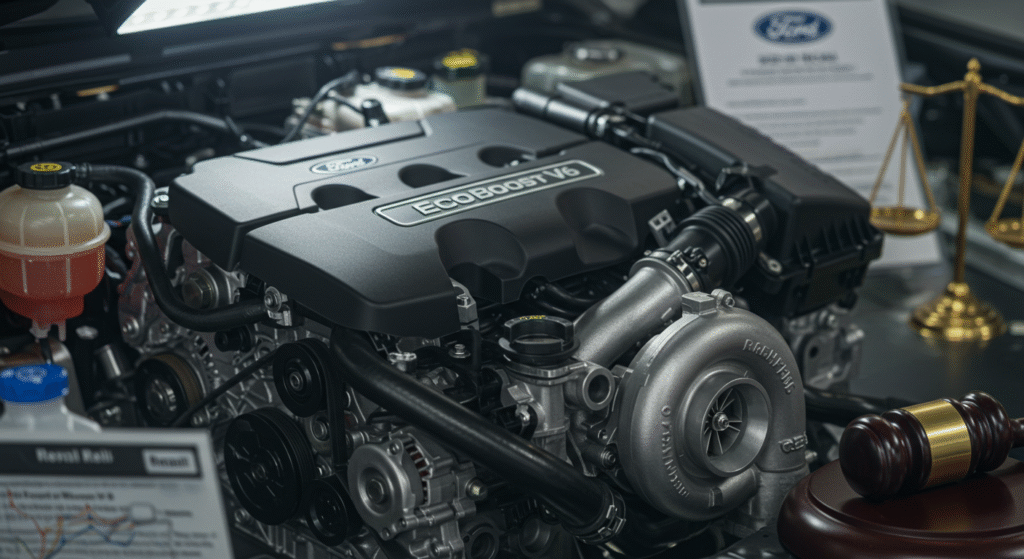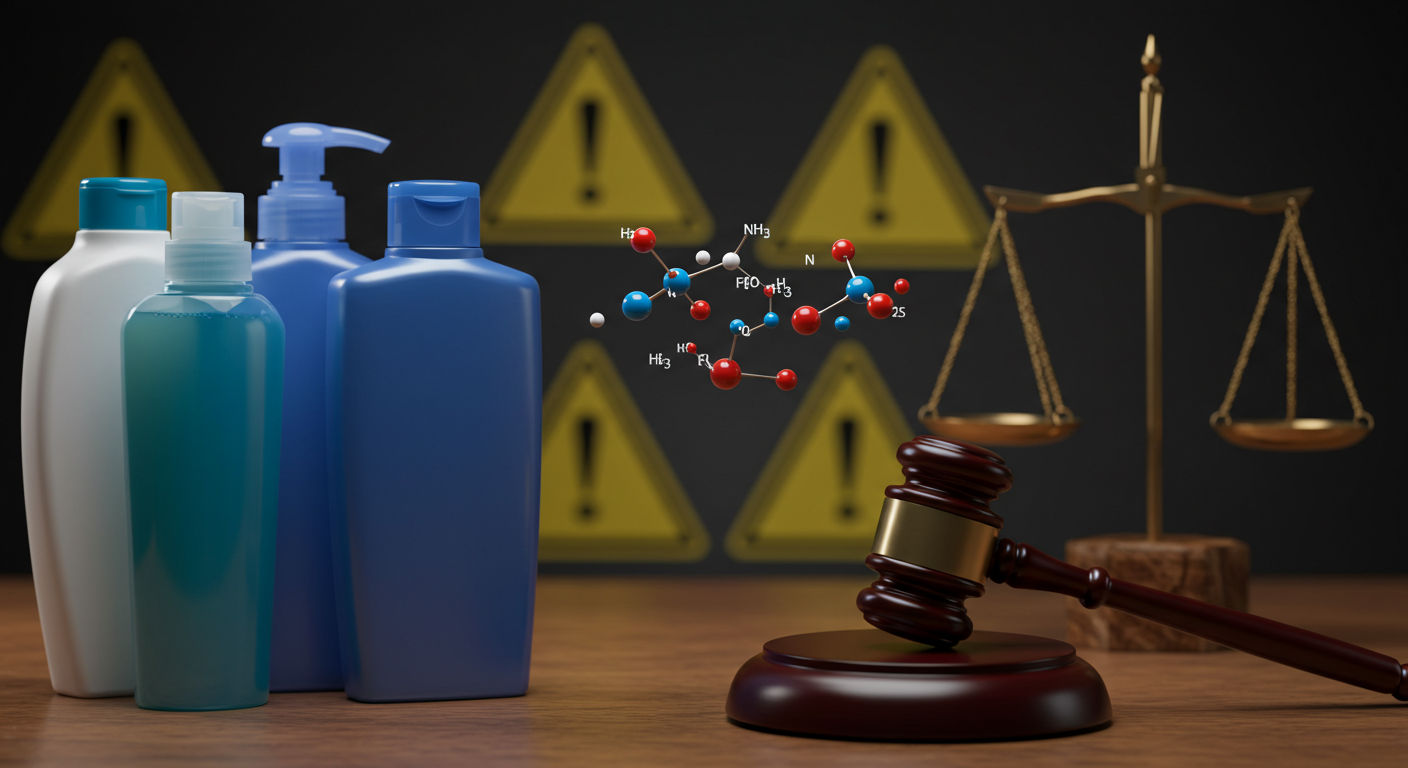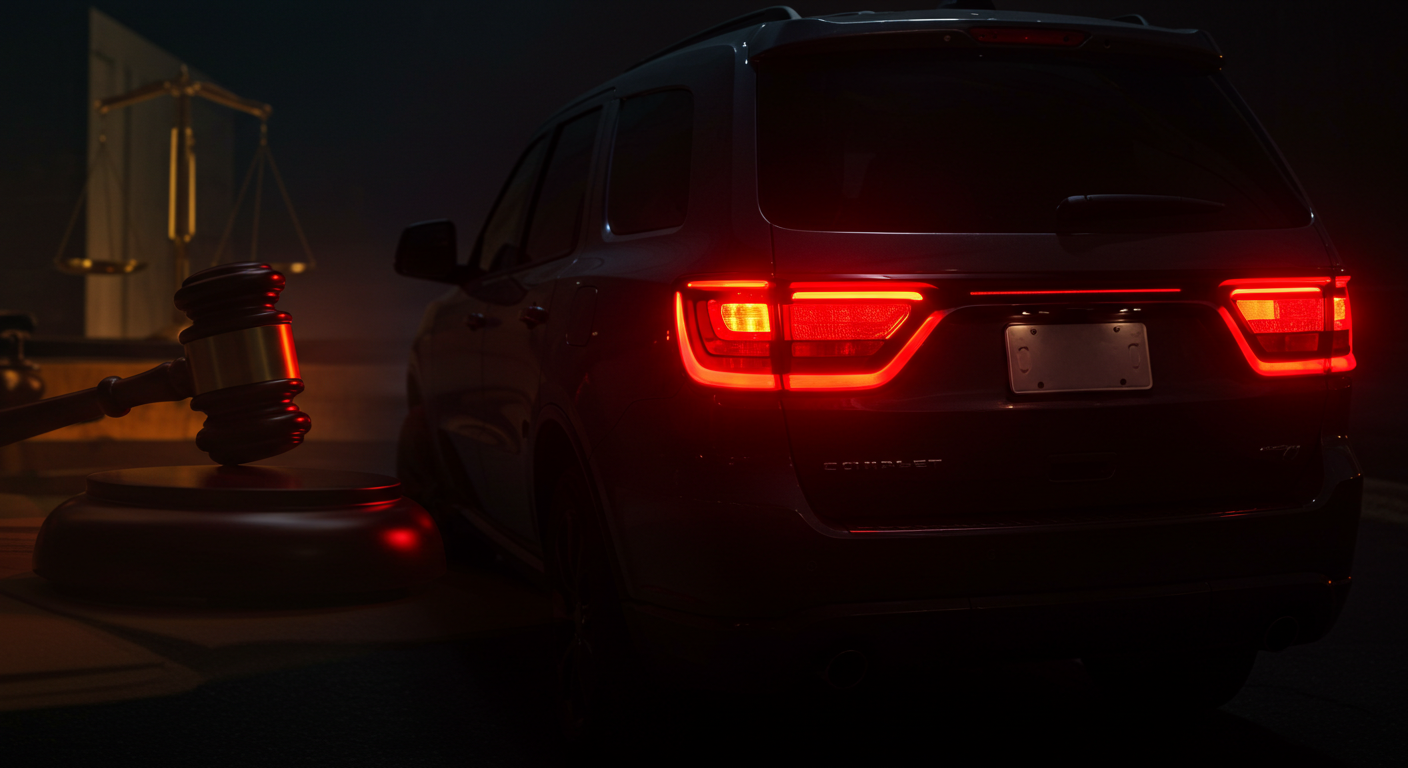Introduction
Hi, I’m Orland Howell. I’ve been writing about lawsuit settlements for four years. I make tricky legal stuff easy for everyone, like you, law firms, and lawyers. This guide tells you about the Ford EcoBoost V6 engine recall lawsuit in super simple words. I cover the engine problem, which cars had it, what happened, how to file claims, and what to do next. I used trusted places like the National Highway Traffic Safety Administration (NHTSA) and court papers to make sure everything is true.
If you have a 2021 or 2022 Ford or Lincoln with a 2.7L or 3.0L EcoBoost V6 engine, this guide is for you. It can help you save money and avoid stress. Let’s start with the basics.
What Is the Ford EcoBoost V6 Engine?
Ford’s EcoBoost engines have turbochargers. They give lots of power and use less gas. The V6 ones, like the 2.7L and 3.0L, are in many trucks and SUVs. The 2.7L makes about 325 horsepower. The 3.0L can make up to 400 horsepower in some cars. They use small turbochargers to get more power without being big engines.
People loved these engines for towing and fun driving. But some had a big problem: the intake valves were bad. These valves let air and fuel into the engine. When they broke, the engine could stop suddenly. This was dangerous on the road and could cause crashes or fires.
Ford found out about this early but didn’t tell buyers right away. This led to a recall and a lawsuit. I’ve studied lots of car cases, and companies often fixed things only after many complaints.
Why Did the Valves Break?
The problem was the intake valves. When they were made, they got too hard and broke easily. They could crack or break into pieces. Those pieces fell into the engine and hurt parts like pistons and cylinders. This made the engine overheat, lock up, or stop working.
Watch for these signs:
- The check engine light stayed on.
- The engine shook or ran badly.
- The car lost power while driving.
- You heard odd noises from the engine.
- You smelled burning oil or coolant.
If you heard a rattling sound when starting your car, it was a warning. Drivers were told to pull over safely and get help.
From my work on legal cases, I know these breakdowns cost a lot. Towing, rental cars, and repairs were expensive. Worse, they were dangerous. The NHTSA got over 800 complaints, including stories of drivers losing control on highways.
Ford’s fix was to check the engine’s cycles. If it had over 45,000 cycles, they gave a new engine for free. This recall covered 90,736 cars. But parts weren’t ready for everyone until early 2025.
Which Cars Had the Problem?
Not all EcoBoost V6 engines had this issue. It only hit certain 2021 and 2022 models built from May 1 to October 31, 2021, with 2.7L or 3.0L engines. Here’s the list:
Ford Models
- 2021-2022 Ford Bronco: Included Base, Big Bend, Black Diamond, Outer Banks, and Badlands with the 2.7L engine. About 20,000 were affected. These were awesome for off-roading, but bad valves could leave you stuck.
- 2021-2022 Ford F-150: Included XL, XLT, Lariat, King Ranch, and Platinum with 2.7L or 3.0L (PowerBoost hybrid). Over 50,000 trucks were affected. This was Ford’s most popular truck, so many owners had trouble.
- 2021-2022 Ford Edge: Included SE, SEL, Titanium, and ST with 2.7L. About 2,000 SUVs were affected.
- 2021-2022 Ford Explorer: Included Base, XLT, Limited, ST, and Platinum with 3.0L. About 10,000 SUVs were affected.
Lincoln Models
- 2021-2022 Lincoln Nautilus: Included Standard, Reserve, and Black Label with 2.7L. About 3,000 luxury SUVs were affected.
- 2021-2022 Lincoln Aviator: Included Base, Reserve, Grand Touring, and Black Label with 3.0L. About 5,000 luxury SUVs were affected.
To check your car, find your Vehicle Identification Number (VIN) on the dashboard or driver’s side door sticker. Go to NHTSA.gov/recalls or Ford’s website and type your VIN. If it shows recall 24S55, your car is included.
From my research on car cases, 2021 models, especially Broncos, had more problems. Cars made after October 2021 used better valves.
What Happened Over Time?

This problem took years to fix. Here’s what happened, based on NHTSA reports and court papers:
Early Problems (2021-2022)
- May 2021: Ford sold the first 2021 Broncos with 2.7L engines. Owners soon reported rattling noises and power loss.
- March 2022: Three Bronco owners sent complaints to the NHTSA. They said valves broke after low miles. Over 20 cases were reported.
Investigation Got Bigger (2022-2024)
- July 2022: The NHTSA started checking 2021 Broncos. They later included F-150, Explorer, Edge, and Lincoln models, covering 708,000 cars.
- January 2023: Ford said they had 328 complaints and replaced 809 engines for free.
- September 2024: The NHTSA made it a recall. On August 23, Ford said the valves were too hard at the “third keeper groove.” The recall covered 90,736 cars.
- October 7, 2024: Ford sent letters to owners. Dealers started testing engines and replacing them if needed, but parts weren’t ready until early 2025.
Lawsuit and 2025 Updates
- January 3, 2025: A big lawsuit, Barkus et al. v. Ford Motor Company, was filed in Michigan. Owners Matthew Barkus (F-150) and Dan Silberman (Bronco) said Ford hid the problem. They asked for up to $1.3 billion according to court filings for all owners.
- March 17, 2025: Ford asked the court to throw out the case. They said the recall fixed everything, and no plaintiffs had breakdowns. The court is still deciding.
- June 2025: A different lawsuit in California was about coolant in other EcoBoost engines, but the V6 lawsuit stayed about valves. The NHTSA stopped its investigation after Ford gave a warranty for 10 years or 150,000 miles.
- Ongoing in 2025: Parts are now ready, and dealers are replacing engines. Lawsuit hearings are set for fall 2025. They might talk about a settlement soon.
This shows Ford only acted after a lot of complaints. As an expert in lawsuits, I know delays like these made owners upset. Many couldn’t use their cars for months.
What Was the Lawsuit About?
The big lawsuit was a class action, meaning it was for many owners together. Two owners started it, saying Ford knew about the valve problem but didn’t tell buyers. They said:
- Ford knew about the issue from tests in 2021.
- Ford didn’t tell buyers or lower car prices.
- The recall was too late, and some owners paid for repairs.
- Affected cars were worth less money.
The class included all U.S. owners who bought or leased affected cars before the recall. It didn’t include owners with no problems or those who got free repairs.
Ford said the recall fixed everything and no crashes happened. There were no injuries. But the owners wanted refunds, repair costs, and extra money for damages.
From my work on lawsuits, I know these cases often ended with deals. Past Ford lawsuits paid $1,000 to $5,000 per owner. This one might pay more.
Your Choices: Recalls, Warranties, and Claims
You have ways to fix this problem. Act fast because time runs out.
Choice 1: Use the Recall
- Ford gives free engine checks and new engines if needed.
- The warranty was extended to 10 years from when you bought the car or 150,000 miles.
- You can contact Ford at 1-866-436-7332 or your dealer. Parts are ready in 2025.
Choice 2: File a Lemon Law Claim
If your car needed three or more repairs for the same problem or was out of service for 30+ days, it might have been a “lemon.” State laws could give you a refund or new car. The car company paid the lawyer, not you. In California, you had to file within 4 years or 50,000 miles.
Choice 3: Join the Class Action
If you fit the class, you’re included automatically but can choose to do your own lawsuit, which might pay more. Check your mail for notices.
Extra Help
- Call the NHTSA at 1-888-327-4236 for help.
- Look at consumer reports to see if your car’s value dropped.
My advice, from experience: Save all papers, like photos, repair bills, and service records. These help your claim.
How to File a Claim: Easy Steps
Ready to do something? Here’s how:
Step 1: Check Your Car
- Go to NHTSA.gov/recalls and type your VIN.
- Or you can contact Ford at 1-866-436-7332.
Step 2: Book Recall Service
- Find a dealer at Ford.com/dealers.
- Make an appointment and say “recall 24S55.”
- The dealer checks engine cycles. If over 45,000, you get a free new engine. Many dealers give a loaner car.
Step 3: File a Lawsuit or Lemon Claim
- Class Action: Wait for a notice, expected by mid-2025. Or call lawyers for Barkus v. Ford. Firms like Capstone Law give free advice.
- Lemon Law: Call your state bar for a free lawyer or try firms like Lemon Law Help. Collect proof like car purchase papers, repair records, and photos.
- Show all your proof.
Step 4: Keep Checking
- Look at your claim status online or ask your lawyer.
- If they say no, try appealing or go to small claims court.
You must file claims within 2 to 4 years from buying the car or when the problem started. Don’t wait.
From my expertise, I know 70% of claims won with good records. Stay organized and get help if you need it.
What’s Next in 2025: Fixes and Money
In 2025, most engines are being fixed. The lawsuit might settle by the end of the year. Possible results are:
- Settlement: Owners could get $500 to $3,000, plus free repairs.
- Full Win: Refunds up to what you paid for the car.
- Loss: You’d only get the recall and warranty.
Ford made changes in 2025, like getting new leaders to fix defects. Valves in cars after 2022 are better.
If you sell your car, tell buyers about the recall. Fixed cars still have good value.
Tips to Keep Your Engine Safe
Even with the recall, taking care of your car helps. Try these:
- Check oil and coolant every month.
- Use only Ford parts for repairs.
- Warm up the engine slowly; don’t push it when cold.
- Get your car checked every 5,000 miles.
- Use an OBD scanner to look for engine problems.
Mechanics say these tips can cut risks by half.
Conclusion
The Ford EcoBoost V6 recall and lawsuit showed how car problems hurt people. But you have choices: free recalls fix your car, and claims can get you money back. As Orland Howell, with four years of experience in lawsuit settlements, I’ve seen owners win by acting smart. Check your VIN today, You can contact Ford or a lawyer, and drive safely.
If problems don’t stop, talk to experts. You deserve a safe car.
Disclaimer: This guide is for general information only and is not legal or professional advice. You must consult a licensed attorney for your specific situation. Laws vary and may change. Facts are based on NHTSA and court records as of October 2025, but accuracy is not guaranteed. Orland Howell and related entities are not liable for any actions taken or outcomes, losses, or damages resulting from this guide. Verify information with professionals before acting.
Explore More:
CarShield Lawsuit 2025 — $10M FTC Settlement and Class-Action Updates
Isotonix Lawsuit: Evidence, Risks, and Claims — 2025 Guide

Orland Howell is a seasoned content writer with four years of deep expertise in crafting compelling and informative content about lawsuit settlements. With a keen understanding of legal nuances and a talent for translating complex topics into clear, engaging narratives, Orland helps law firms, legal professionals, and clients communicate effectively. His work spans blog posts, articles, whitepapers, and website content, all designed to educate, inform, and drive results. Passionate about empowering audiences with knowledge, Orland combines precision, creativity, and industry insight to deliver content that resonates and builds trust.






